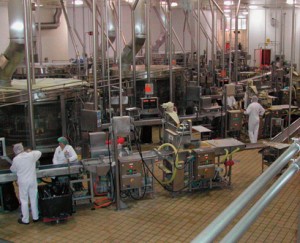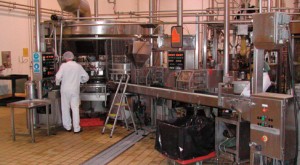The original project to automate the production of savoury pancakes was undertaken in conjunction with Gainsborough Craftsmen who built six machines in the mid-1990s for Findus Ltd, in Newcastle-upon-Tyne.

The production hall at Findus.
I was responsible for programming and commissioning these machines. Findus continues to use my services for supporting and upgrading the equipment to this present day.
Three machines feed finished pancakes onto a conveyor to be taken to the freezer. Behind this line is another identical line of three machines. Each machine produces approximately 100 savoury pancakes per minute in a process that is totally automatic, with a reject rate of less than one in a thousand (0.1%). Automating production reduced the number of operators from a total of about fifty to just two operators per machine whose main responsibility is checking product quality.
The most significant innovation with these machines is the use of servomotors for driving all mechanisms, and intelligent 12-axis servo controllers for interlocking linked motions, which replace traditional cams and gearboxes. Consequently, every function can be finely adjusted to compensate for small changes in the process or ingredients.
During this long relationship I have been responsible for:
- Replacing the original, obsolete controllers with new controllers from Trio Motion Technology
- Upgrading the vision systems
- Designing a bespoke PCB (printed circuit board) for interfacing the existing vacuum fluorescent (VF) displays to the new controllers
The Operation
The machine is in two parts: the first is a rotary hotplate on which the crepes are made and the second is a linear conveyor on which they are filled, folded over and sealed.
The first operation is to make the crepes by depositing metered shots of batter mix onto a circular hotplate that rotates continuously; speed and temperature of the hotplate are controlled so that the crepes cook within one revolution. The crepes are then removed from the hotplate and placed on a belt conveyor by a transfer unit that picks them up using a specially developed vacuum head.
The second operation is to fill and seal the pancakes. After being placed on the conveyor, the crepes pass under a vision system that determines their size, shape and position on the belt. This position is passed to the downstream stations that automatically adjust the starting point of their operations to coincide precisely with the arrival of the crepes. At the first station, a precisely metered amount of filling is extruded onto the crepe; at the second, the crepe is folded over to form a semicircular pancake; at the third, the pancake is sealed by a crescent-shaped tool that crimps the edge.
The filling, folding and crimping stations ignore any crepes that fail the vision test because they are not properly formed or because they are too far out of position and these are removed from the belt conveyor by the operator.
The filling, folding and crimping stations are each driven by servomotors. The folding mechanism is particularly ingenious, simulating the human hand and wrist by gripping the leading edge of the crepe as it passes beneath the station on the conveyor and folding it over in a single, smooth action. Hand and wrist are driven by two servomotors synchronised together by a complex cam profile stored in the servo controller. Operation of the transfer unit and conveyor are geared to the rotation of the hotplate and operation of the filling, folding and crimping stations are geared to the conveyor by the controller.

Machine showing the rotary hotplate (left, background) on which batter mix is deposited for making crepes and the conveyor (right, foreground) with stations for filling, folding and crimping the pancakes




Follow Tim!